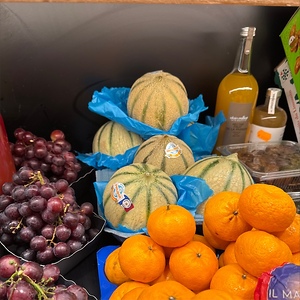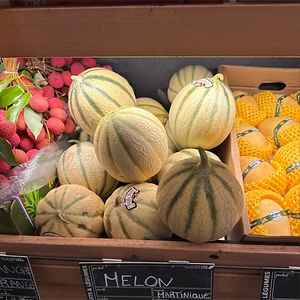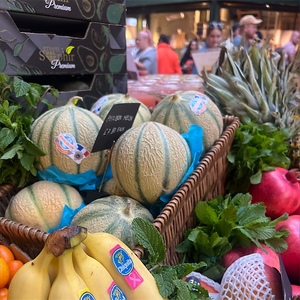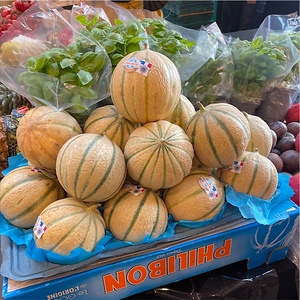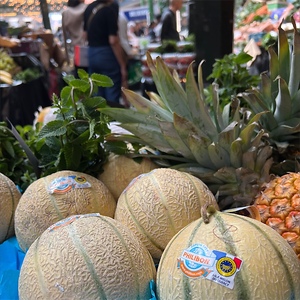


Philibon Melons
Estimated Inventory, ea : 0
Description/Taste
Philibon melons are a small varietal, averaging 7 to 10 centimeters in diameter and 1 to 1.5 kilograms in weight, and have a round to slightly oval shape. The melon’s rind is thin, hard, rough, and netted, ranging in color from grey-green to pale green. The skin also showcases prominent mottled dark green vertical striping. As the melon matures, the coloring of the stripes will darken or stay the same, depending on cultivation, and the base grey-green coloring will sometimes acquire a yellow hue. Underneath the surface, the pale orange to orange-red flesh is dense, aqueous, and succulent with a firm but tender consistency. The melon also encases a central cavity filled with oblong ivory seeds suspended in stringy fibers. Philibon melons are aromatic, emitting honeyed, fruity, and floral notes and are easily recognized by their perfumed scent. The melons should feel heavy for their size, indicating the juice content within the flesh. Philibon melons contain high sugar mixed with mild acidity, creating a very sweet, refreshing flavor followed by a pleasant, soft floral aftertaste.
Seasons/Availability
Philibon melons are available almost year-round. The melons are grown in several regions throughout the northern and southern hemispheres, providing a steady, seasonal supply. In France, Philibon melons are available from mid-June through mid-September. In Spain, the melons are harvested in early June. Outside of Europe, Philibon melons are cultivated in Guadeloupe and Martinique from February through April. They are also produced in Morocco from mid-September through October and Senegal from mid-November through late January.
Current Facts
Philibon melons, botanically classified as Cucumis melo var. cantalupensis, are a specialty variety belonging to the Cucurbitaceae family. The small, firm-fleshed melons are a type of yellow Charentais melon grown and marketed under the Philibon brand based in France. Philibon melons are the flagship product of the Philibon company, and approximately 60% of the melons are sold in French markets, while 40% are used for export to high-end retailers worldwide. Philibon melons do not have extended storage capabilities and are delicate in shipping, causing them to be transported only through air carriers. This ensures the melons retain their refreshing qualities and allows them to be shipped long distances without damage. Philibon melons are also produced in small quantities to control the growing, shipping, and branding process. Philibon melons are cultivated in open-air fields and are harvested and packaged by hand. The melons are favored among fruit enthusiasts for their light, floral, and fruity taste and are traditionally consumed fresh to appreciate their soft, aqueous, and melting consistency.
Nutritional Value
Philibon melons are a source of beta-carotene, a nutrient converted into vitamin A in the body, helping to maintain healthy organ functioning. The melons also provide vitamin C to strengthen the immune system while reducing inflammation, fiber to regulate the digestive tract, B vitamins to convert food into energy, potassium to balance fluid levels within the body, and lower amounts of zinc, calcium, magnesium, copper, and iron.
Applications
Philibon melons have a sweet, floral, and subtly fruity flavor well suited for fresh preparations. The melons can be sliced and consumed fresh in wedges, a popular serving method in the summer in France. Philibon melons can also be sliced into green salads, mixed into fruit bowls, sprinkled with herbs and citrus juice as a refreshing side dish, or wrapped in prosciutto as an appetizer. The melon’s sweet flesh complements neutral breakfast dishes, including cereal, waffles, parfaits, and crepes, or they can be halved, hollowed, and topped with grains, cottage cheese, or ice cream. In addition to fresh culinary dishes, Philibon melons can be blended into smoothies, pressed into juice, or combined with other fruits into frozen concoctions. They can also be pureed into gazpacho, served with veal and other roasted meats, stirred into grain bowls, or served as a reprieve to fried foods such as shrimp fritters. For dessert, Philibon melons can flavor granita, sorbet, or ice cream, balled and used as a decorative topping over cheesecake, or served as a healthy after-dinner snack. Philibon melons pair well with herbs such as basil, mint, and rosemary, pomegranates, citrus, fennel, cheeses, including parmesan, feta, and goat, and nuts such as pine, hazelnuts, and pistachios. Whole, unwashed Philibon melons should be stored at room temperature, away from direct sunlight, until ripe. Once the melons are fragrant and mature, they become highly perishable and keep 2 to 6 days when stored in the refrigerator.
Ethnic/Cultural Info
Philibon melons received an Indication of Geographical Protection, or IGP when grown in Guadeloupe, an archipelago of twelve islands in the Caribbean. The French territory began growing the melon in the 1980s through the vision of the Boyer family, owners of the Philibon brand, and the variety received its PGI in 2009 under the name Melon de Guadeloupe. The archipelago is known for its limestone-rich soil, warm tropical weather, and ample sunshine, and the melons are cultivated in 10 municipalities, mainly on the islands of Grande-Terre and Marie-Galante. Melon production is the region’s third-largest agricultural commodity, after bananas and sugar cane, and the melons are hand-harvested and flown to France within three days of picking to ensure freshness. In Guadeloupe, the melons are typically consumed fresh, sometimes sprinkled with lime juice, vinegar, or basil leaves. Philibon melons grown in Guadeloupe often feature the name Melon de Guadeloupe beside the brand name Philibon on their market stickers in France, a label highlighting the melon’s region-specific quality.
Geography/History
Philibon melons are a type of Charentais melon that was branded using a marketing name for increased consumer appeal. Charentais melons are native to Southeastern France and were bred from selective cultivation of cantaloupe varieties. The melons remained localized to their native growing region until the mid-20th century, but with the establishment of railways to Paris, Charentais melons became famous throughout France for their sweet flavor. Philibon melons were branded by Claude Boyer and his family, owners of the Boyer company, and the melons are sold under the Philibon brand, a specific sector of the company. The Boyer family were known melon producers in France, and in 1968, the Philibon brand was established to promote and sell the family’s signature melons. The Boyer family also traveled to the Caribbean in 1980 and saw that the climate was ideal for melon production. Philibon melons were soon being cultivated in Guadeloupe and Martinique, and the brand later expanded production to Senegal, Morocco, and Spain for year-round supply. Today Philibon melons are offered worldwide and are mostly found through specialty retailers, distributors, and high-end markets.
Recipe Ideas
Recipes that include Philibon Melons. One



